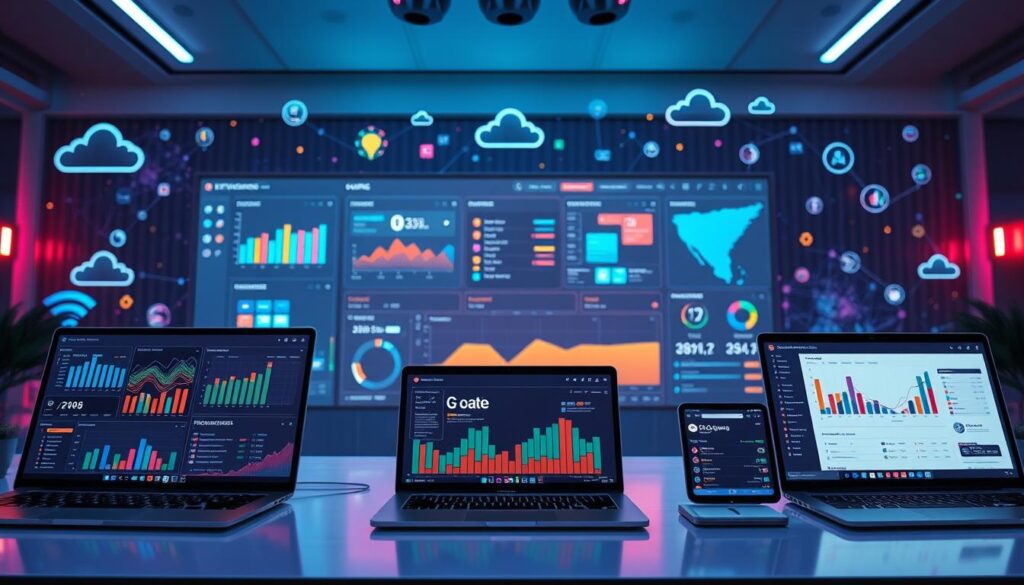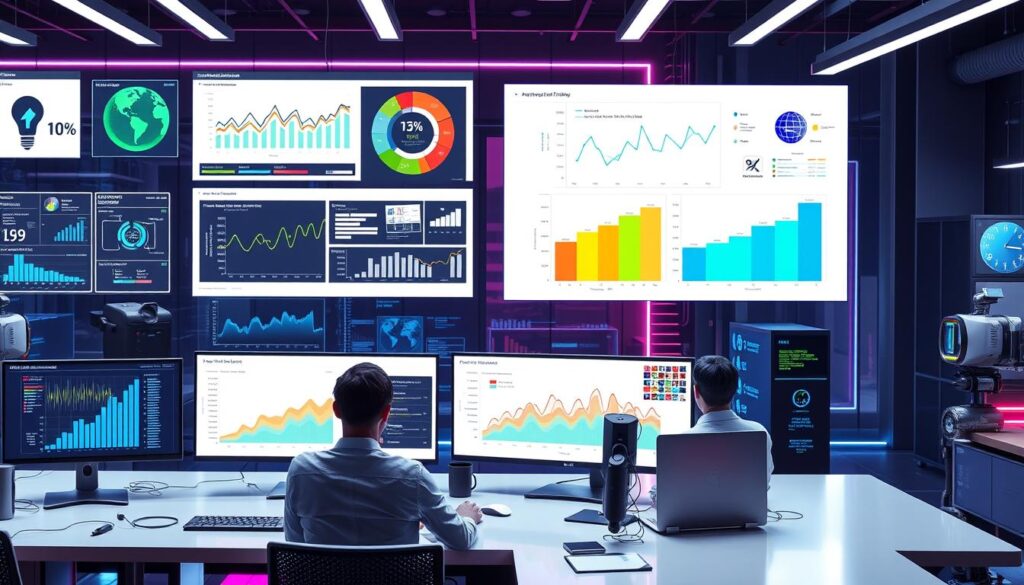In today’s fast-changing digital world, good IT management is key for any business to succeed. Companies aim to make their workflows smoother, boost productivity, and help teams work together better. This makes online IT management tools more important than ever.
This guide will cover the must-have features and benefits of today’s IT management solutions. We’ll look at cloud-based platforms, asset tracking, and network monitoring. You’ll see how these tools can change how your team works.

Key Takeaways
- Discover the evolution of IT management solutions and their role in modern digital infrastructure
- Explore the key components of centralized IT management systems and their benefits for remote teams
- Learn about cloud-based IT management platforms and their advantages for distributed workforces
- Understand the essential features of IT asset management software and how they streamline inventory and compliance
- Gain insights into network monitoring and performance analysis tools for optimizing IT infrastructure
Understanding Modern IT Management Tools
The world of digital technology is always changing. IT management solutions have changed a lot too. Now, we see cloud-based systems instead of old on-premises setups. This big change helps organizations manage their IT better.
Evolution of IT Management Solutions
IT management has come a long way. In the beginning, each task had its own software. But as IT got more complex, a single, all-in-one solution was needed. That’s when enterprise IT management suites came along. They offer a single place to manage all IT needs.
Key Components of Digital IT Infrastructure
- Hardware assets, such as servers, desktops, and mobile devices
- IT asset management software for tracking and managing these assets
- Software applications and licensing
- Network and security infrastructure
- Cloud-based services and solutions
Benefits of Centralized Management Systems
Using IT asset management software and enterprise suites has many benefits. These include:
- Improved visibility and control over IT assets
- Enhanced asset lifecycle management and compliance
- Streamlined IT operations and reduced operational costs
- Increased team collaboration and productivity
In today’s digital world, modern IT management tools are key. They help optimize and secure IT infrastructure for businesses.
Cloud-Based IT Management Platforms for Remote Teams
In today’s world, cloud-based IT management platforms are key for remote teams. They offer a central place to manage and keep an eye on digital systems. IT experts can check and fix many IT issues from anywhere, at any time.
Cloud-based IT management platforms are great for remote monitoring tools. These tools help IT teams find and fix problems quickly. They make sure remote workers have the best performance and access to their systems.
| Feature | Benefit |
|---|---|
| Remote Monitoring | Proactive identification and resolution of IT issues across distributed networks |
| Asset Inventory Management | Centralized visibility and control over IT assets, including hardware and software |
| Automated Patch Management | Streamlined deployment of software updates and security patches to maintain system integrity |
| Collaboration Tools | Seamless team coordination and knowledge sharing for efficient IT support |
Cloud-based IT management platforms help remote teams work better. They make IT support more efficient and keep systems safe. As work changes, these platforms will help teams stay ahead.

Essential Features of IT Asset Management Software
Today, managing IT assets is key. IT asset management software helps track, organize, and optimize your IT resources. It’s vital for IT teams to know what makes these tools essential.
Asset Tracking and Inventory Management
IT asset management software tracks your IT assets well. It keeps tabs on their location, status, and lifecycle. This way, you can use your resources better and avoid losing them.
License Management and Compliance
Keeping software licenses in check is important. IT asset management software makes this easier. It tracks licenses, monitors usage, and warns you of any issues. This helps you avoid fines and make the most of your software.
Asset Lifecycle Management
IT asset management software handles your assets from start to finish. It helps plan for upgrades, manage maintenance, and handle asset retirement. This approach saves you money and boosts your IT’s value.
| Feature | Benefit |
|---|---|
| Asset Tracking and Inventory Management | Improved visibility and control over IT assets, reducing losses and ensuring efficient utilization |
| License Management and Compliance | Automated license tracking and compliance monitoring, preventing costly fines and optimizing software investments |
| Asset Lifecycle Management | Streamlined asset procurement, maintenance, and retirement, maximizing the value of IT infrastructure |
Using IT asset management software helps manage your IT infrastructure monitoring. It optimizes resource use and keeps your IT ecosystem compliant.
Network Monitoring and Performance Analysis Tools
In the fast-paced world of IT, network management and monitoring tools are key. They help keep networks running smoothly and systems working well. These tools give IT teams a clear view of their network’s health and efficiency. This lets them spot and fix problems before they cause trouble.
Network monitoring tools give a detailed look at your network. They track important metrics like bandwidth use, packet loss, and latency. IT experts can quickly find and fix issues, making the network more reliable and fast.
Performance analysis tools go deeper, looking at how each part of your IT works. They check server load, app performance, and how resources are used. This helps teams find ways to make things better and more efficient. With real-time data and history, IT managers can tackle performance problems and keep apps running smoothly.
- Gain visibility into network health and performance
- Identify and address potential issues before they impact operations
- Optimize resource allocation and improve overall efficiency
- Make data-driven decisions to enhance the performance of your IT infrastructure
Using a range of network management solutions and IT infrastructure monitoring tools, IT teams can manage their network and infrastructure well. This ensures top performance, reliability, and quick response to business needs.

Online IT Management Tools and Their Impact on Efficiency
In today’s fast-paced digital world, IT teams rely on IT automation tools and IT operations management (ITOM) software to improve their work. These tools help manage IT infrastructure better. They lead to better productivity, cost savings, and teamwork.
Productivity Improvements Through Automation
Online IT management tools automate repetitive tasks. This lets IT pros focus on important projects. They handle tasks like software updates and incident response with little human help.
This automation increases productivity and reduces errors. It makes IT work more reliable and efficient.
Cost Reduction and Resource Optimization
These tools also help save money and use resources better. They give IT teams control over the whole IT setup. This helps find and fix waste, and makes buying easier.
Automating tasks also cuts down on the need for manual work. This leads to lower costs.
Team Collaboration Enhancement
Good IT management needs teamwork, and these tools help a lot. They have chat features, real-time monitoring, and shared data. This lets teams work better together, share knowledge, and solve problems faster.
Using online IT management tools boosts efficiency and teamwork. This helps businesses succeed and stay competitive.

Security Integration in IT Management Platforms
More and more companies use online IT management tools to make their work easier. These tools are key to keeping data safe and following rules. They help make work more efficient and protect important information.
Data encryption is a big part of these tools. It keeps information like employee details and financial data safe. This makes it hard for hackers to get to this information.
User access control is another important feature. It lets admins decide who can do what with IT assets. This keeps the company safe from inside threats and makes sure only the right people can access things.
| Security Feature | Description | Benefits |
|---|---|---|
| Data Encryption | End-to-end encryption of sensitive data | Protects confidentiality and prevents data breaches |
| Access Control | Role-based permissions and user authentication | Restricts unauthorized access and mitigates internal threats |
| Audit Logging | Comprehensive tracking of user activities and changes | Enables compliance monitoring and incident investigation |
| Vulnerability Scanning | Proactive identification of security vulnerabilities | Facilitates timely remediation and strengthens IT infrastructure |
These tools also have audit logging. It keeps a detailed record of what users do and changes made. This helps with following rules, solving security problems, and keeping the company safe.
Vulnerability scanning is another key feature. It finds and fixes weak spots in the IT system. This helps keep the company’s digital stuff safe from hackers.
These security features show how important it is to have a strong IT security plan. Using these tools helps keep data safe, follow rules, and make the IT system stronger. This makes the company more secure and competitive.

Implementing ITSM Tools for Better Service Delivery
In today’s digital world, IT service management (ITSM) tools are key for better IT operations. They help teams improve their service desk, incident management, and change management. This leads to better IT service delivery overall.
Service Desk Implementation
The service desk is the main contact point between IT teams and users. A good service desk solution with easy ticketing, self-service, and automated workflows boosts IT support efficiency. This makes users happier and IT issues get fixed faster.
Incident Management Workflows
Good incident management is key to keeping IT systems running smoothly. ITSM tools help set up standard incident workflows, from logging to tracking. This quickens IT responses, cuts downtime, and boosts service quality.
Change Management Processes
IT changes are a fact of life, and managing them well is vital. ITSM tools support strong change management, from impact assessments to rollback plans. This keeps IT stable and secure, reducing risks and improving service quality.
Using ITSM tools helps streamline IT operations and boosts service delivery. As technology keeps changing, IT teams will keep using ITSM tools to deliver top-notch service.
IT Infrastructure Monitoring Best Practices
Keeping your IT infrastructure running smoothly is key. By watching how your network, servers, and other IT stuff do, you can spot and fix problems fast. Here are some top tips for monitoring your IT:
- Prioritize Key Metrics – Pick the most important things to watch, like server uptime and network speed. Focus on these to get the most useful info.
- Automate Monitoring Processes – Use tools to make monitoring and analyzing data automatic. This lets you keep an eye on things and get alerts right away.
- Implement Centralized Dashboards – Put all your monitoring data in one place. This makes it easy for your team to see and fix problems.
- Leverage Predictive Analytics – Find tools that use predictive analytics. They can help you see problems coming and stop them before they start.
- Foster Collaboration and Transparency – Make sure everyone can see the monitoring data. This helps teams work together and make better decisions.
Following these tips will help you build a strong IT infrastructure monitoring system. This lets your team keep your digital stuff running well, making your whole team more efficient and productive.
“Effective IT infrastructure monitoring is the foundation for a resilient and responsive digital ecosystem.” – IT Management Expert
Selecting the Right IT Management Solution for Your Team
The digital world is always changing. Finding the right IT management tools is key for teams of any size. Whether you’re small or big, managing your IT well can boost your team’s work.
Assessment Criteria for Tool Selection
When looking at IT management tools, think about several important points. These help find the best tool for your team. Key things to look at include:
- Functionality: Does the tool have what your team needs, like tracking assets and managing licenses?
- Ease of Use: Is the tool easy to use? This makes it simple for your team to start using it.
- Scalability: Can the tool grow with your team and organization? It should handle more work and team members as needed.
- Integration Capabilities: Can the tool work well with your current systems? This helps keep things running smoothly.
Integration Capabilities
It’s important to think about how well a tool integrates with your systems. Good integration means your IT management works better. Look for tools that fit well with what you already use.
Scalability Considerations
Your IT needs will change as your team grows. Choose a tool that can grow with you. Think about how it handles more data and users, and if it can change to meet your needs.
By looking at these important points, you can pick the best IT management tool. It will help your team work better, make your operations more efficient, and support your company’s growth.
Conclusion
Online IT management tools are key for today’s teams dealing with digital infrastructure. They range from cloud-based platforms to asset management software. These tools have changed how IT pros handle their work.
Centralized management systems help teams work better together. They make tasks more efficient and cut costs. Tools like these also improve how teams track assets and deliver services.
Security is a big part of these tools. They include top-notch IT asset management software. This keeps digital environments safe and follows rules, protecting important business assets.
The digital world keeps changing, making online IT management tools even more vital. By using these tools, companies can stay ahead. They empower IT teams to face future challenges with ease and skill.
“The future of IT management lies in the seamless integration of cloud-based platforms and intelligent automation. By harnessing the power of these tools, organizations can unlock unprecedented levels of productivity and agility.”
Choosing the right tools is crucial for your IT journey. Look for solutions that fit your team’s needs. Make sure they grow with your business and encourage constant improvement. With the right tools, your IT management will excel, helping your company reach new success levels.
Future Trends in Online IT Management Tools
The digital world is changing fast, and online IT management tools are set to see big changes. Experts say we’ll see more AI and predictive analytics. This will help IT teams work smarter and predict problems before they happen.
Remote monitoring will get better, making it easy for IT pros to check on their systems from anywhere. This is great for teams that work from different places or follow hybrid work models. It helps keep everything running smoothly.
IT automation and remote monitoring will work together to make things more efficient and save money. IT teams will focus on solving big problems instead of doing the same tasks over and over. This new way of managing IT will change how companies handle their tech in the future.
FAQ
What are the key benefits of using online IT management tools?
Online IT management tools boost productivity by automating tasks. They also cut costs and improve team work. These tools make managing IT easier and more efficient.
How do cloud-based IT management platforms support remote teams?
Cloud-based platforms help manage IT resources for remote teams. They offer remote access and real-time monitoring. This keeps IT teams in control, even when working from home.
What are the essential features of IT asset management software?
IT asset management software tracks and manages assets. It also handles licenses and the asset lifecycle. This ensures assets are used well and meet licensing rules.
How do network monitoring and performance analysis tools improve IT operations?
These tools keep IT systems running smoothly. They spot problems and monitor traffic. This helps IT systems work better and faster.
What are the security considerations for IT management platforms?
IT management platforms have strong security features. They protect data and meet industry standards. This includes access controls and encryption to keep information safe.
How can ITSM tools improve IT service delivery?
ITSM tools make IT services better by streamlining operations. They improve how IT teams handle requests and manage changes. This leads to faster service and less downtime.
What best practices should be considered for IT infrastructure monitoring?
Good monitoring starts with setting up a solid system. It’s about understanding data and fixing problems early. This keeps IT systems running well and quickly fixes issues.
What key criteria should be considered when selecting an IT management solution?
When picking an IT solution, look at how well it fits your needs. Check if it integrates with your systems and can grow with you. This ensures the solution meets your IT needs now and in the future.
